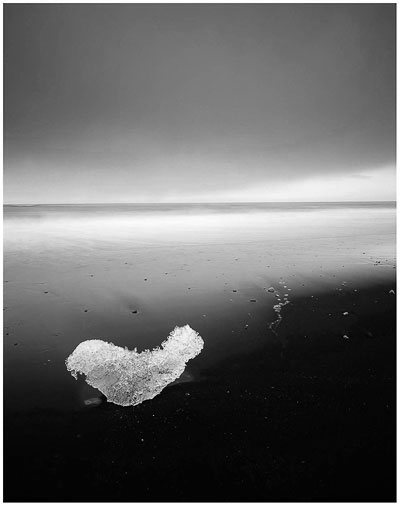Following on from my previous two posts (white Canvas and then Black Canvas) where I discussed the use of snow (white canvas) or black sand (black canvas) as a blank canvas in which to place isolated objects thus creating a simplified composition / photograph, it's time to talk about incorporating the two.

Of course, the title of this post suggests I'm talking about black and white photography. I'm not. I'm just amalgamating the previous two posts together. If you've not read them, then I suggest that you do, as they are really the foundation to where I'm going with all of this.
You see, for me, photography is not about great scenery. It's about tonal compositions. If we abstract a scene down to the basic building blocks we have tone and form. That's all we have. We don't have trees, we don't have rivers, we don't have beaches. Forget all those 'meaningful' handles we have for things out there in the world. They're really irrelevant and a massive distraction to what we're really doing in photography. So what is it that I think we're trying to do in photography?
Well, a number of things actually. But perhaps the most important one is that we're trying to make sense of the world, to distill what we see in front of us, down into a digestible, accessible message. We wish to compartmentalise what we see down into something we can understand, and that hopefully everyone else will too. We do this by using maths (spacial distances between related objects within the frame), and by mood (dark tones convey a sense of mystery or low feelings, while brighter tones are more uplifting and transparent).
But ultimately, everything we see within the frame is a tone. It is somewhere between absolute black and absolute white. I honestly wonder sometimes - if we could paint onto the sensors / film of our cameras what we want, we would. We're just dealing in tones.
So am I suggesting we all start working in black and white? Sort of, but not quite, but yes. I am.
Recently, while I was in Lofoten, one of my clients - John - was working with his D800 camera and I noticed he was working with his live-view screen set to black and white only.
I loved this.
To me it was the perfect summary of what it is we're trying to do as photographers.
What John was trying to do, was consider the tones in front of him. By removing the colour element, he was able to be more focussed on the tonal relationships before him, and the form they convey throughout the scene. By working with a black and white preview screen, he was abstracting.
Photographs aren't about scenery, they're about form and tone.
I began this discussion by presenting a white landscape (snow), to illustrate how we can reduce our photography down to the absolute zero in terms of content to a frame, and if we're good at it, we can make stronger images. I feel working in blank landscapes such as snow and beach locations can help us fine tune our photography. We start to realise we don't need much, and everything that is put into the frame should have a purpose.
Like Mark Hollis fromTalk Talk said "Before you play two notes learn how to play one note - and don't play one note unless you've got a reason to play it." The same holds true for photography. We must distill our image making down to what it really is, and it's not about scenery, it's about form and tone. Start with less form and work up from there is my advice.
